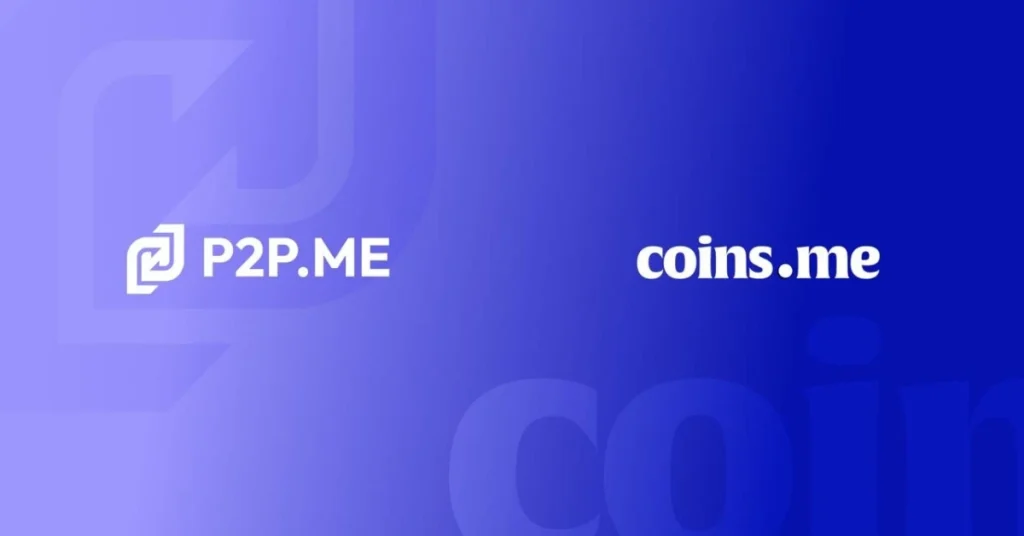The CEX Experience in a DEX: P2P.me Launches Coins.me for Simple, Gas-Free Crypto Swaps

The post The CEX Experience in a DEX: P2P.me Launches Coins.me for Simple, Gas-Free Crypto Swaps appeared first on Coinpedia Fintech News
They call this the #CEXyDEX.
Crypto has long split between ease of using centralized exchanges vs self-custody and transparency of DeFi. P2P.me, an on-chain protocol on Base, has been has been trying to bridge the gap by creating decentralized ramps between fiat and crypto. And now the team is taking the next step with Coins.me, a consumer app that makes using crypto feel as simple as UPI or PIX.
A Network Built on Decentralization and Trust
P2P.me in itself enables instant, private swaps between USDC and local fiat by connecting verified liquidity providers and users via smart contract order matching. Each order is peer-to-peer, with fiat settlements verified using zero-knowledge proofs (ZKPs), so transactions clear in under 90 seconds without exposing personal data. Order books, dispute resolution, and reputation all run on-chain, rewarding good actors and penalizing fraud. The design removes custodial risk and central intermediaries while maintaining reliability.
Backed by Coinbase Ventures and Multicoin Capital (co-leading a $2M seed round in April 2025), P2P.me is moving from infrastructure to consumer experience with Coins.me.
The Foundation: Base + On-Chain Ramps
Built on Base, P2P.me has been redefining fiat–crypto movement with on-chain speed and simplicity.
Public Dune data shows steady 2025 growth in volume, active wallets, and transactions in the p2pme protocol. Highlights include:
- Consistent MoM volume growth in India and Brazil, reaching $13.9M as of this writing.
- Average settlement under 90 seconds, validating real-time efficiency.
- Repeat usage by verified liquidity providers, indicating network trust and stability.
These signals suggest Coins.me launches as an evolution of a protocol already serving real demand.
Source: https://dune.com/p2pme/latest
As of October 2025, the network has processed $13.9M across 165,263 completed orders from 19,123 unique users, with $2.06M in October month-to-date—averaging roughly $100K per day.
Introducing Coins.me
Coins.me is a simple self-custodial DEX that allows users, old or new, to one-tap buy into the top cryptocurrencies in the world. It removes gas friction and simplifies on-chain swaps. Powered by Uniswap V3 under the hood, it delivers CEX-like ease while staying fully decentralized.
Key features:
- One-tap login: Google, phone, or passkey. A smart wallet on Base is created automatically—no seed phrases, still self-custodial.
- Gas-free swaps: Network fees are sponsored, so users don’t juggle gas or pop-ups for multiple allowance transactions.
- Fast in-built ramps: At launch, users in India, Brazil, and Indonesia can buy or sell via UPI, PIX, or QRIS. More countries are planned to launch this soon.
- Privacy-preserving compliance: ZK proof verifications and a reputation-based score keep users verified yet private.
“People shouldn’t have to choose between convenience and control for investing into coins,” said a P2P.me spokesperson. “Coins.me makes entering the crypto world feel intuitive and familiar without giving up on any of the principles of decentralization that make it valuable.”
Built for the Next Hundred Million
Decentralized apps often lose mainstream users to complexity. Coins.me flips that by focusing on high-velocity payments markets and abstracting private keys, gas, and bridging. Transactions settle on Base for transparency and auditability while users get a fintech-grade interface. It’s also a natural stablecoin gateway to crypto adoption, letting users in emerging markets hold or transfer USDC and buying other top cryptocurrencies, without the need of centralized exchanges.
“Built on Base, the open protocol plans to launch a token to shift control to the community,” CoinDesk reported earlier this year, noting P2P.me’s path toward user and LP-led governance and upcoming TGE / token launch.
Beyond a Wallet
Coins.me combines smart contract wallets, gas sponsorship, and privacy-preserving verification—a blueprint for the next wave of Web3 consumer apps. Custody and private keys remain with the user while the experience rivals traditional finance.
By keeping custody and private keys entirely in the user’s control while offering an experience comparable to traditional financial apps, P2P.me is signaling that decentralization and usability can finally coexist.
Industry observers have framed P2P.me as “a decentralized platform for fully on-chain fiat swaps with zero-knowledge KYC and DAO governance to combat fraud.” Coins.me now carries that philosophy to the end-user.
What’s Next
Coins.me is live globally for swaps, with ramps currently in India, Indonesia, and Brazil. Road-map items include a governance token, expanded fiat rails across Africa, Asia, and Latin America, and tighter integrations.
The ambition is clear: make crypto useful for anyone, anywhere—without forcing them to learn its complexities—while staying true to decentralization and privacy. With a gas-free interface, instant local payments, and self-custodial security, Coins.me shows what a user-first Web3 experience can look like.
P2P.me is also planning for a TGE for their token launch by March 2026, where a discounted token sale pre-TGE will occur for users with completed ZK verifications and executed orders on the P2P protocol.
For millions already fluent in digital payments, Coins.me may be the easiest path into crypto. For P2P.me, it’s the culmination of a two-year push to make decentralization practical, fast, and human—redefining “on-chain” as a normal part of everyday life.
You May Also Like

‘Great Progress’: Cardano Founder Shares Update After CLARITY Act Roundtable
Read the full article at coingape.com.
Going For Huma Finance Vanguard On Solana

